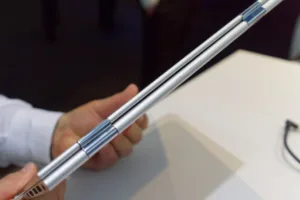We wrote about the Analogix Nano-console at CES. Now the product is getting close to shipment. The firm was also at the show to promote the Slimport/MyDP technology, but there was no news since CES.
Archos showed a variety of smartphones and tablets, with the Archos 50 Diamond being completely new to its line up. The smartphone comes with a 5″ IPS full HD display, Android 4.44 Kitkat, 4G radio, Qualcomm octacore 615 processor and 16GB of internal storage. They also offer dual SIM card capability for the €229 price.
 BeTouch of Korea has a cheap camera-based touch systemBeTouch of Korea was in the innovations area with a very low cost camera and pen-based system for adding interactivity to surfaces, including displays. There were few technical details available although we did establish that the pen is active. Although shown with a camera a few metres from an LCD display, staff told us that the camera did not have to be mounted centrally to the display surface. The system costs $99 and if it really does work well, that could be disruptive in the large screen market! It has just started to ship in Korea.
BeTouch of Korea has a cheap camera-based touch systemBeTouch of Korea was in the innovations area with a very low cost camera and pen-based system for adding interactivity to surfaces, including displays. There were few technical details available although we did establish that the pen is active. Although shown with a camera a few metres from an LCD display, staff told us that the camera did not have to be mounted centrally to the display surface. The system costs $99 and if it really does work well, that could be disruptive in the large screen market! It has just started to ship in Korea.
Cisco showed network solutions and how those help the development of the internet of things.
Cogito is offering a traditional wristwatch with Bluetooth connectivity to Android and iOS devices. Like similar smartwatches, they offer a screen that shows alarms as well as text messages. In contrast to the others, they completely rely on a watch battery to power the device instead of a rechargeable battery. They claim “several months” of battery life in their press material. From the look of the display, it could be a electrophoretic display, which would explain the long battery life as well. This could however not be confirmed at MWC.
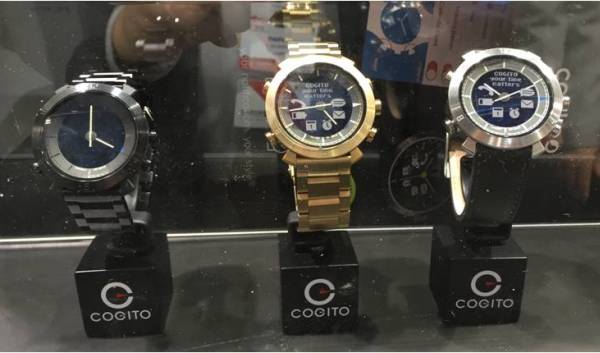
Dell was at the show, but the only new product it had to talk about was the nice tablet (the Venue 8 7000) that we saw at CES.
Dialog Semiconductor was showing the curved 70″ FlatFrog display that we featured in a video from our ISE report. Dialog is the supplier of the detector chips used in the system so has a good incentive to promote big displays – the bigger display, the more detectors are needed. We had heard after ISE that the FlatFrog system needed “a lot of power” to work, but Dialog told us that actually, the system uses a relatively simple microcontroller and that the processing overhead is not high. Dialog also showed us how its very low power (mWs) audio system could be used as a voice trigger to power on a smartphone with a key phrase. The firm also had resonant charging technology using its Bluetooth controller, which also supports the A2DP audio over Bluetooth profile.
 DisplayLink showed Android running on a PC dock via USBWe reported on a new wireless system developed by DisplayLink to allow Android devices to work with PC docking stations. At MWC, the company was showing support (Android Lollipop only) for wired connections on phones with USB2Go. DisplayLink plans to have an app available on the Google Play store by the summer to allow simple use of tablets and smartphones with docking stations and full sized displays and peripherals. As DisplayLink reminded us, Microsoft Office is available (including OneNote and Outlook) on Android tablets (as long as they have displays from 7″ to 10.1″).
DisplayLink showed Android running on a PC dock via USBWe reported on a new wireless system developed by DisplayLink to allow Android devices to work with PC docking stations. At MWC, the company was showing support (Android Lollipop only) for wired connections on phones with USB2Go. DisplayLink plans to have an app available on the Google Play store by the summer to allow simple use of tablets and smartphones with docking stations and full sized displays and peripherals. As DisplayLink reminded us, Microsoft Office is available (including OneNote and Outlook) on Android tablets (as long as they have displays from 7″ to 10.1″).
Android does not directly support multiple displays, but it does support “clone” operations as standard. If the application is correctly configured, it can run in “presentation” mode, where what is shown on the attached display is different from what is shown on the integrated phone or tablet display.
Dolby was at the show to promote its Atmos technology which is being included by mobile device makers including Lenovo. The challenge is to deliver the full “Atmos experience” everywhere from dedicated installations in cinemas (apparently the recent Eindhoven installation (Dolby HDR Updates from CES 2015) is one of the very best). The firm told us that it had been very pleased with the results at ISE a couple of weeks ago. It was the first time that the firm attended and had seen lots of installers and A/V specialists and is planning a return.
Fitbit showed its complete line of products at MWC 2015. There was nothing completely new as the models have already been announced before. The product range does fit well into the wearable category reaching from simple fitness bands to higher end models that fall more in the smartwatch category. The high end Surge model comes with a touch enabled monochrome LCD and allows for communication with the smartphone via Bluetooth, which puts it into the smartwatch category. Of course as a Fitbit device the first focus is on the fitness tracking abilities.
HP‘s news was of the Spectre X360 notebook. This has a very cool “dual spiral gear” hinge which rolls the display around the rounded end of the notebook. The notebook is just 15.9mm thick and a FullHD IPS touch panel that covers the sRGB gamut and has a 13.3″ diagonal. The display is optically bonded to enhance contrast. Despite the thin body (apparently machined from a solid block of aluminium), the battery has a capacity of 56WH and this is said to give a benchmark life of 12.5 hours or 10 hours of continuous video. Both HDMI and DisplayPort outputs are provided and our notes commented on the good performance of the display. Processors are up to 5th Gen Core i7 and SSDs up to 512GB are available. Pricing starts at €999.
HP’s Sphere X360 has an innovative hinge system and is very thin
Martian Watches showed a line of traditional time keeping pieces that is basically a mechanical watch with additional displays allowing for messaging and other functions. These displays are really small 96 x 16 pixel OLED displays that allow only for limited information flow to the user. However, the watches also connect to Android and iOS smartphones via Bluetooth and allow access to voice commands via embedded microphones. The advantage of this approach lies in the longer battery life of up to 5 days, compared to other smartwatches in the 1 to 2 day range.
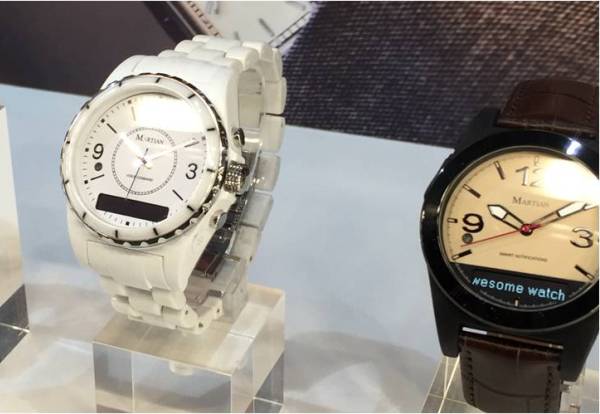
Martian also powered the Guess Connect watches shown at MWC.
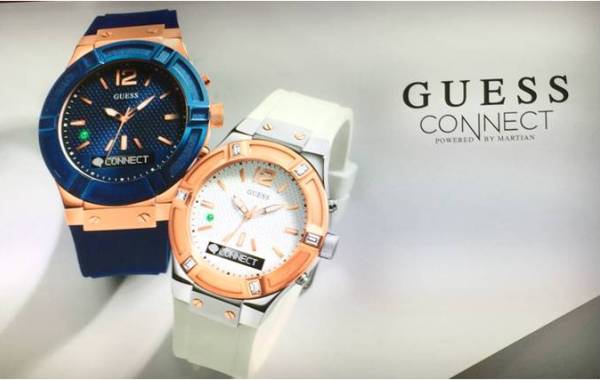
In our CES report on Mediatek we mentioned that the firm had promised us more news at MWC and we were not disappointed. The company re-iterated its Clear Motion technologies that bring me/mc technology, colour enhancement and sharpening from the TV space to mobile devices. However, new at MWC was a set of technologies that Mediatek calls “Smart Screen”. These use pixel by pixel analysis of images to optimise contrast and legibility over a wide range of brightness conditions. The firm couldn’t give a lot of detail but insisted that the importance of the technology is that it operates at the pixel level and not over all the display.
The Helio X10 is a new chip that includes the Smart Screen technology. It can support displays up to 120Hz and can record video at up to 480fps. The chip is reported to directly support Chrome OS and has 8 cores to support video up to UltraHD. The chip uses 8 Cortex A-53 cores (rather than the common four big/four small octo designs) and there will be a later version that uses 8 Cortex A-72 cores. The X10 is said to be comparable to the SnapDragon 810 from Qualcomm.
 Mediatek’s SmartScreen Technology looked better in “real life” than in this picture
Mediatek’s SmartScreen Technology looked better in “real life” than in this picture
It’s been a couple of years since NEC Display Solutions was part of the MWC show. This year, there was a “theatre” experience on the NEC booth, with projection mapping. There was quite a good demonstration of mapping onto solid 3D objects, using dual projectors, but we couldn’t find anybody that could give us more information.
 NEC showed projection mapping
NEC showed projection mapping
There were no display related news at NTTDoCoMo. Research news was about portable SIM cards, tactile sensation navigation and 5G networks.
As expected there were no phones on the Nokia booth for the first time, instead the company showed its new corporate face for the first time. The Nokia at the show was the part that is exploiting the assets not acquired by Microsoft. This part of the company employs six to seven thousand people and operates in the consumer, automotive and enterprise markets. The automotive group suggested an automotive solution that brings traffic and safety alerts to the edge of the cloud where it can be accessed by network-enabled cars with very little latency compared to smartphone-based solutions. Other offerings were software solutions to drive the various displays in a car and navigation and mapping services.
ONO is a Spanish cable company that was acquired by Vodafone last year and was one of the main proponents of Tivos in Spain. With a shift to 4G and FTTH connectivity (there is a plan to connect up to 2 million homes to FTTH), the company expects more video to be transmitted and is developing a “virtual STB” concept where Tivo-based functionality is in a cloud server. The company sees the distribution of data out to many localised HDDs as being very inefficient – it’s much better to store the data once in the cloud, where it can be made available on any device. Vodafone will also sell ONO-branded STBs in retail stores.
We heard that Peraso of Canada would be talking about 60GHz technology, so we tracked them down. The company had been at CES and had talked about its WiGig adaptors which use its technology in a dongle format. The dongle uses the firm’s PRS4000 WiGig baseband SoC and is said to be the first in production. At MWC, the emphasis was not on the client and user end, but on the use of the technology in backhaul and infrastructure applications. A feature that was being emphasised is the small amount of energy per bit being used. Although the apparent power of 60GHz technology is higher, so much more data is transmitted in a short time, the energy per bit is much lower.
Pixelworks was showing its mobile phone technology, but we covered this in our CES report and in a Display Daily by Ken Werner, so there was nothing really new at the show, although the company did emphasise that the improvement in video quality in recent years is making quality problems more obvious.
We haven’t reported on Qterics before, which slightly surprised us (it was previously known as Update Logic). The company was on the Silicon Image booth (it is a subsidiary of Silicon Image but got $7 million of investment from Qualcomm at the end of 2014) and specialises in support and diagnostics software that can be integrated into Blu-ray Disk players, STBs, tablets and SmartTVs. The software allows remote call centres to interrogate and analyse conditions on internet connected devices to give a high level of user support. Clients of the company include Sharp (in the US) and Sony worldwide. The company also has remote services and provisioning for software upgrades and content provision.
Real VNC showed its mirror link technology for using smartphone devices in the car. While the connected car was a big theme at MWC in general, Real VNC banks on using the existing smartphone connection and its mirror link technology to connect to the automobile. Among the supporters of the technology are the VW group, Renault group, Honda and Toyota. In other words, some “heavy hitters” in the car world. Mirror link allows the smartphone to take over the car displays depending on the particular design, including running apps installed on the phone. To cope with the various regulations, the system will allow only certified apps to run while the car is moving. It is up to the app developer to receive such certification, making sure to avoid distractions from the driver.
Ruwido, our favourite high end designer remote control company, was at the show with a very stylish (of course) design for a remote control with a matching (and tiny) set top box enclosure. The company was exhibiting for the first time and was hoping to meet some different clients. Among its prestigious clients is Mercedes Benz – Ruwido provides the remote for the entertainment system in the “S” class series.
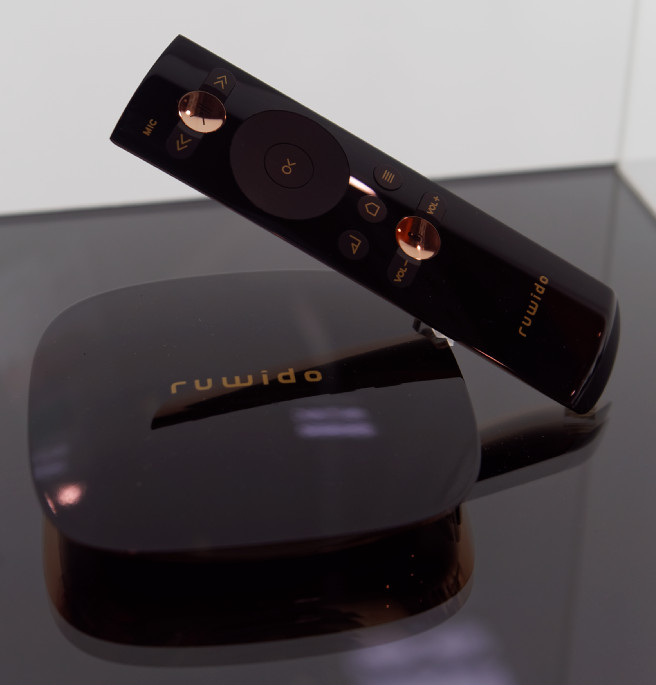 Ruwido showed this attractive STB design Concept
Ruwido showed this attractive STB design Concept
SAP was showing vending machines fitted with full size LCDs and allowing sophisticated vending applications. SAP told us that it had found it difficult to get many vending machine companies involved because of their relative lack of interest in new technology. Eventually, the firm worked with Vendors Exchange to develop the kiosk. (http://www.veii.com – but not working when we checked it).
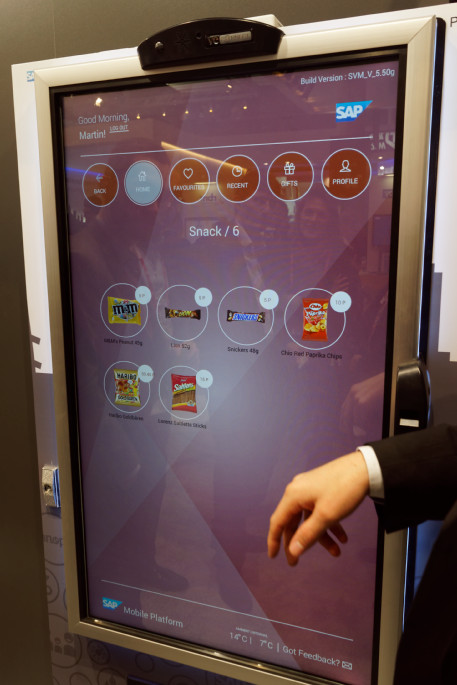 SAP told us that it found it hard to get this Vending System developed by major vending system makers.
SAP told us that it found it hard to get this Vending System developed by major vending system makers.
STMicroelectronics is gradually showing less and less that is display-related. However, the firm told us how the low power touch technology it has was used by Samsung in the Galaxy S5 Edge where particular attention needed to be paid to palm touch rejection. The company’s controller also stays on when much of the rest of the system is powered down so that edge gestures are detected and recognised, which demands extremely low power operation. The integrated controller can also be used for signature and pattern teaching and recognition, without needing the main application processor, which can mean a significant saving in power and in system development.
Technicolor had a meeting room and was talking about its connected home products. We first looked at technology that Technicolor has developed to allow access to its home gateway for remote diagnostics of the home systems including Wi-Fii quality so that operators can fix problems of users in their networks.
The Technicolor STB team were at another show, but there was a demonstration of a set top box that could connect not only to broadcast IPTV sources, but also to EMBMS transmissions over LTE. The operating system is full Android and staff described it to us as a “nomad box” that could “follow you”. For example, the box could be carried between a main home and a holiday home. The box also supports high end (up to UltraHD) games. Technicolor can supply the box with a customer interface or Android or Google.
We then had a look at the firm’s smart home technology. There is a view that the smart home will “never work” – it’s too complicated, in Technicolor’s view. Instead, the firm has looked at typical “pain points” and developed software that helps the consumer by being a kind of “agent”. For example, there is a “door man” that can look after and report on security aspects including keeping track of who is in the house using a camera with face recognition. The box uses HMDI in and out to overlay on top of a TV signal so that the TV becomes the “centre of the smart life”. The system supports Allseen technology, which is widely adopted, except by very large companies which think they can tie in consumers to their own systems.
Texas Instruments had a private meeting room where they showed some of the products from the show floor, as well as some not available. While TI did not announce any new chipsets at the show, it had a Sekonix pico projector on display that reminded this reporter a lot of the keychain projector it showed last year. There was also the projector-enabled tablet from Lenovo and some other microprojectors on display. Overall projectors did not play a big role at MWC.
The TransferJet Consortium was sharing a booth with the SD Association with which it completed a collaboration agreement around a year ago. The group was emphasising kiosk applications for speeding transfer to SD cards and other memory. We asked about the advantage compared to, for example, 802.11ad, which Qualcomm was talking about and we were told that the negotiation time of 20ms is quicker than Wi-Fi. The SD Card Association was talking about new MicroSD card standards that support faster transfer speeds, which will be identified as UHS-II. This will be important for UltraHD and higher resolution video. Transfer speeds go up to 312 MB/second and SDXC cards now go up to 2TB capacity.
Vestel was showing 55″ curved FullHD and UltraHD TVs as well as the smartphones and tablets that it is increasingly trying to promote.

